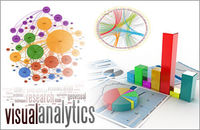Assign2
| Assignment 1 | Assignment 2 | Assignment 3 | Assignment Dropbox |
Contents
Interactive Data Exploration and Analysis (IDEAL)
Overview
In this digital economy age, massive and complex data have been captured and stored in organization databases and/or data warehouses. By and large, these data contain a large amount of variables of a particular product or activity. Due to limitations in perceptual and screen space, graphical techniques available in traditional business intelligence systems tend to confine to univariate and bivariate data such as bar chart, pie chart and scatterplot. As a result, many important relationships that live in these data remain undiscovered. In this assignment, you are required to apply interactive data exploration and analysis techniques to discovery patterns from multivariate data. The goal of this assignment is not to develop a new visualization tool, but to apply the interactive data exploration and analysis techniques you have learned by using commercial-of-the-shelf and opensource software. It also aims to allow you to gain hands-on experiences on using the visualization tool and at the same time, to evaluate the pros and cons of the tool in real world applications.
Data Sets
We have provided the following data sets and would like to encourage you to use one of them in order to get started quickly and therefore have more time to explore the data and develop your analysis questions.
Data Visualisation System Design Process
Step 1: Identify a theme of interest
Each of the dataset provides a wide range of parameters that can be used for many different purposes. Hence, it is very important for you to identify a theme clearly before you start your investigation. For example, you might want to focus on issues related to business competitiveness.
Step 2: Define questions for investigation
After you have identified a theme, you should now formulate questions for investigation. For example: Is there a relationship between sales revenue and marketing expenditure? Are the growth of GPD per capita and the growth of productivity correlated? Are there different patterns of energy consumption in different regions of the world?
Step 3: Find appropriate data attributes
Extract and download the datasets in convenient formats such as Excel or a CSV file. The online database contains a lot of tabulated data. In some cases, you will need to convert the data to a format you can use. Format conversion is a big part of visualization research so it is worth learning techniques for doing such conversions.
You will need to iterate through these steps a few times. It may be challenging to find interesting questions and a dataset that has the information that you need to answer those questions.
Recommended Best Practice
After you have the initial question and the appropriate datasets, construct a visualization that provides an answer to your question. As you construct the visualization, you will find that your question evolves – very often, it will become more specific. Keep track of this evolution and the other questions that occur to you along the way. Once you have answered all the questions to your satisfaction, think of a way to present the data and the answers as clearly as possible. The presentation must be in the form of interactive visualization.
Before starting, write down the initial question clearly. And, as you go, maintain a wiki notebook of what you have to do to construct the visualizations and how the questions evolved. Include in the notebook where you get the data from, and documentation about the format of the dataset. Describe any transformations or rearrangements of the dataset that you need to perform; in particular, describe how you get the data into the format needed by the visualization system. Keep copies of any intermediate visualizations that have helped you refine your question. After you have constructed the final visualization for presenting your answer, write a caption and a paragraph describing the visualization, and how it answers the question you posed. Think of the figure, the caption and the text as materials you might include in a research paper.
You should maintain a session on the assignment wiki documents all the questions you asked and the steps you performed from start to the end .
Visualization Software
To perform the analysis, you are encouraged to explore the following Data Visualisation toolkits:
- Tableau
- Qlik Sense
- Power BI
and specialised visual analytics techniques
- Ternary diagram
- Parallel coordinates
- Trellis
- Mosaic plot
- Divergent bar chart
- Parallel Sets
- TableLens
- Treemap
One of the goals of this assignment is for you to learn to use and evaluate the effectiveness of these visualization tools. Please do not hesitate to consult me if you encounter problems in using the tool.
Useful resources
Submission details
This is an individual assignment. You are required to work on the assignment and prepare submission individually. Your completed assignment is due on 26th September 2016, by 11.30am.
You need to edit your assignment in the appropriate wiki page of the Assignment Dropbox. The title of the wiki page should be in the form of: IS428_2016-17_Term1_Assign2_FullName.
The assignment 2 wiki page should include the URL link to the web-based interactive data visualization system prepared.
Assignment 2 Q&A
Hi everyone,
I'm working with the food data so I'm not sure if this is useful for other projects.
A friend recommended this tool called http://openrefine.org and it provides a GUI for cleaning data.
I found it helpful and it could be even more helpful for more non technical people.
All the best, Aaron.
Need more clarification, please go here
